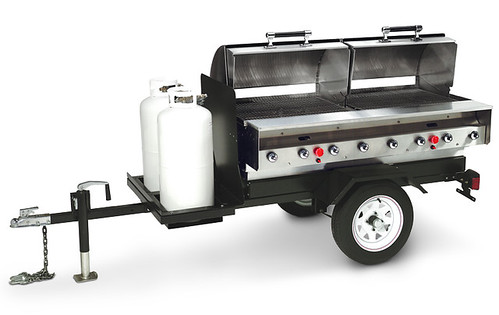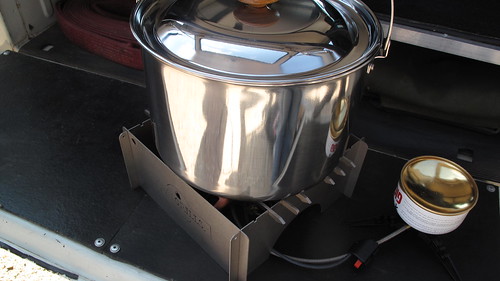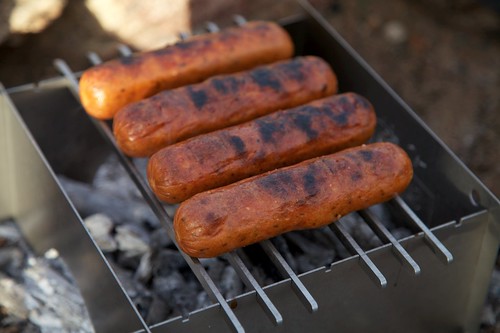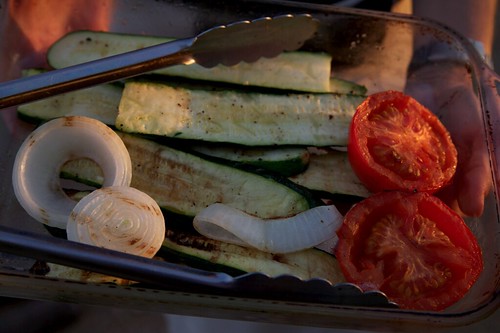
There’s rich irony in the fact that many of us cook on five-foot-wide, $1,500 stainless-steel propane grills in our back yards, where our only view over the wall is the top of the neighbor’s head as he cooks on his own six-foot-wide, $2,000 grill (with counterbalanced rotisserie)—but when we have a brai out in Mother Nature’s beautiful scenery it’s usually on a flat wire grid balanced on rocks, or a theft-proof Forest Service grill with slats spaced 1.5 hot-dog widths apart. Yet short of something like a Belson Porta-Grill:

. . . it’s impractical to bring along a proper grill on a wilderness outing. Even a compact Weber charcoal grill takes up a lot of cubic storage space—and it only does one thing.
That’s why Chris Weyandt developed the SlatGrill, a collapsible barbecue that cooks with charcoal or can double as a sturdy pot or griddle support and windscreen for a compact stove.
The SlatGrill comes in sizes ranging from a one-pound titanium model nine inches square to a 75-pound carbon-steel monster with a two-foot by three-foot cooking area. Every one disassembles and stores flat to travel, taking up but a fraction of its assembled volume. Four laser-cut sheets—anodized aluminum, steel, or titanium depending on the model—assemble via corner slots into a square or rectangle. Individual slats then drop into slots in the top; you can space them widely if you want to set a large pot or griddle on top, or close together for grilling.
At the 2012 Overland Expo, Chris handed me one of the compact titanium SlatGrills to try. With the standard three slats, it weighed just under a pound not including the sturdy canvas case. With the addition of three optional slats (highly recommended for versatility) it weighs just ounces more. The assembled grill immediately struck me as a potentially ideal companion to an ultralight remote-canister stove. Such stoves put out heat to rival any full-size propane or white gas stove, but their weak point remains stability and security for large pots—and sometimes, ironically, for very small things such as a two-cup Moka pot, which can fall though the prong spacing. Also, the windscreens for such stoves are often sub-par. It appeared the SlatGrill could solve all these issues.

Indeed it did. I assembled the grill over a JetBoil Helios. The assembly supported with absolute security our largest, four-liter Snow Peak pot full of water, as well as a diminutive Moka pot. And while the clever snap-on windscreen of the Helios is actually pretty effective, it was easily eclipsed by the SlatGrill’s taller walls in an early morning breeze.

The combination of an ultralight stove and the ultralight SlatGrill creates a versatile cooking system, as at home on a motorcycle with a solo rider as it would be in a full-size four-wheeled vehicle with a small family. If you want two burners, the standard (aluminum) SlatGrill has a 12 by 18-inch surface that would accommodate two compact stoves.
Downsides? The compact titanium model is wincingly expensive at $189. However, a stainless-steel version is available for $69 (and two extra pounds). The mid-size aluminum model is $120; it weighs 3.5 pounds with case. All versions are made in the U.S.
My next step will be to see how the compact SlatGrill works over a little bed of mesquite coals. More soon . . .
Update: Last night I built a compact mesquite fire and let it burn to coals, then dropped the SlatGrill over it and cooked some Andouille sausage. The sides of the grill seemed to concentrate the heat extremely well, and the vent openings on two sides fed the coals the right amount of oxygen to keep them going.

In fact, once the sausages were done there was still enough heat to grill some vegetables.

Two issues arose. First, the grill slats are flush with the top of the grill, so there is nothing to prevent a round hot dog rolling off if it's not level or you bump it with the tongs ( you could set hot dogs lengthwise on the slats but it would halve the number that would fit on the grill since they need to be separated by one slat). Also, the lightweight individual slats are easy to knock out of their notches, and can stick to certain foods. I think the latter problem could be solved if I (or the company . . .) drilled holes crosswise in the ends of the slats, then threaded a wire skewer through all of them, one on each side, creating more of a unified platform. The skewer could of course double as a . . . skewer. The rolling-off issue could be mitigated if the slots for the slats were deeper, so the sides made a bit of a lip.
I also decided the six-slat set is the absolute minimum for grilling, to keep the food securely on top, and three more to fill the entire space would have been even better. Of course those little titanium buggers add to the cost quickly; the stainless versions wouldn't hurt so much.
It would be interesting to try a motorcycle or bicycle journey in an area with abundant firewood, using only a SlatGrill for cooking and leaving all the impedimenta associated with a stove at home. Even as a companion to a stove, the compact SlatGrill adds versatility for large pots and the option of open-fire cooking. Well done, SlatGrill.
(Note to self: Avoid punning before coffee.)
